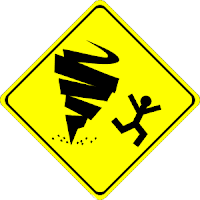 What: Weather Control
What: Weather ControlInvented by: Unknown. I think this probably started as a fantasy trope. You know, magicians controlling weather and the Evil Overlord with a permanent thunderstorm over his Fortress of Darkness. Eventually this moved from fantastical magic to scientific fiction.
Name a book: Cetaganda comes to mind, as does the Price of the stars series. Several other books talk about weather control, force domes that keep weather out, or running from weather.
How is it done? In fiction the weather is typically controlled either with some diabolical device or control screens are made to keep weather out. Or only allow certain weather in. I haven't seen anyone discuss this in depth but I'm guessing a force screen would filter out certain particles, maybe a percentage of the water vapor?
Why would we want this? Speaking as a person living at the cross-roads of Tornado Alley and Hurricane Central, I want this so my roof and electricity stay on! Color me crazy, but I love both those things.
On a broader range of interest, think of all the natural disasters you could prevent with weather control: hurricanes, droughts, flooding... As an author I think about this a lot. Usually I'm thinking, "Wouldn't it be great if my Antagonist could make hurricanes in the middle of Kansas?"
Do we have anything like this now? We have the first baby steps to weather control: weather modification.
If you live in Rocky Mountain ski country you're probably familiar with the term "cloud seeding". This practice, of dropping chemicals (usually silver iodide and dry ice) into a cloud to encourage rain or snow was actually suggested as far back as 1946. The original idea of "rain making" was introduced as a scientific idea in 1903 (or earlier), and it's been hotly debated since then.
 Does it work? From all my research, we have no clue. There is some evidence that cloud seeding increases precipitation by up to 10%. But you have to remember, there is no evidence to compare the seeding to. There is no control.
Does it work? From all my research, we have no clue. There is some evidence that cloud seeding increases precipitation by up to 10%. But you have to remember, there is no evidence to compare the seeding to. There is no control.You can't take two identical clouds in identical places, seed one and not the other, and then measure like you would in the lab. There are just too many variables.
However, people still seed clouds. They also seed them in hopes of preventing rain. Some 24 countries have forms of cloud seeding. And eleven western states (USA) have permanent weather modification programs, as does the Canadian province of Alberta.
Be honest, are there ethics involved? Weather modification and control is one of the few realms of science that you'd think ethics and morals wouldn't get debated in. But it has.
People have accused other countries or states of "stealing rain" because of cloud seeding and other weather modifications. All I can think is, "Seriously??? Stealing rain? Are you nuts?"
Want to learn more? Go check out the North American Interstate Weather Modification Council

Well, on the topic of weather modification and morality, you could look at debates over water rights, also a big issue still. The Colorado River, for example, is barely a trickle relatively speaking by the time it gets to Mexico--because the US takes so much of it for ourselves.
ReplyDeleteIs this right? Is this fair? The debate rages on between states, towns, countries...
The US government is reported to have been fiddling about with weather modification for decades. I recall hearing news mentions of it in the sixties, even.
As far as domes and how they work? I have thought about that myself, and I figure that if the dome is a permeable membrane of some sort, whether it be created by polarity or some other means, it would have to be either 1) solid with permeable sections where the air is filtered, or 2) the membrane/force screen is selectively permeable, a "smart membrane" if you will that either allows the air particles to move at a designated rate into the dome or only selected particles to pass through. Perhaps the dome performs a filtration trick as well, bleeding CO2 and sucking in O2 and other desirable elements?
Written- I lived in Colorado for 8 years and it is a HUGE debate. How much water can we keep? It starts here... right... so that makes it ours... right? Right?
ReplyDeleteAt least people are aware that there is someone downstream, even if they don't allow all the water to flow.
I'm still living here in Colorado, and I have no remorse about our use of water. We didn't choose where the rivers begin, and while we might be able to be economical in its uses (hint hint, quit watering lawns during rainstorms), I don't think its completely our fault if other locales don't get as much water. The amount of water in a given area (or lack thereof) isn't the fault of the people who live there. It just is what it is.
ReplyDeleteWow. Weird. I certainly don't want more snow. LOL!
ReplyDeleteAnne McCaffrey's Acorna series comes to mind for this post. There you do see why morality and ethics comes into seeding. And other weather alterations.
ReplyDeleteSuch a cool idea though. Would be useful in areas of severe drought.